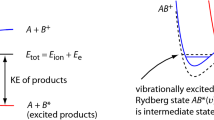Abstract
Various levels of approximation (Hartree-Fock, configuration interaction and double-configuration Hartree-Fock method) are compared for extensive and limited exponent optimization of the atomic orbitals of the wavefunctions. The potential energy curves for the lowest-lying 1 Π u, 3 Π u, 1 Π g, 3 Π g states of the hydrogen molecule are presented. The shapes of the curves on the highest level of approximation, i.e. with the optimal double-configuration wavefunction, are basically in agreement with previous, more sophisticated and time-consuming work. The influence of the various approximations is also studied for several one-electron properties: charge distribution of the wavefunction along and perpendicular to the molecular axis, quadrupole moment and core attraction energy distribution. Differences arise to the work of Zemke et al. [1], who used a limited exponent optimization with a larger basis set, in the Π g states where the π orbitals are very diffuse. The differences concern magnitude and location of minima and maxima of potential curves, as well as considerable changes in one-electron properties which depend strongly on the spatial distribution of the orbitals.
Zusammenfassung
Verschiedene Approximationsstufen (Hartree-Fock, Konfigurationenwechselwirkung und Doppelkonfigurationen-Hartree-Fock-Methode) werden für ausgedehnte und begrenzte Exponentenoptimisierung von Atomorbitalen der Wellenfunktionen verglichen. Die Potentialkurven für die niedrigsten 1 Π u, 3 Π u, 1 Π g, 3 Π g Zustände des Wasserstoffmoleküls werden angegeben. Die Form der Kurven im Rahmen der besten Näherung, d. h. mit Doppelkonfiguration, stimmen im wesentlichen mit früheren aufwendigeren Rechnungen überein. Der Einfluß der verschiedenen Approximationen wird auch an einigen Einelektroneneigenschaften studiert: Ladungsverteilung der Wellenfunktion längs und senkrecht zur Molekülachse, Quadrupolmoment und Verteilung der Rumpfenergie. Unterschiede erscheinen zur Arbeit von Zemke et al. [1], die einen größeren Basissatz mit begrenzter Optimisierung verwandten, bei den Π g Zuständen, wo die π-Orbitale sehr diffus sind. Die Unterschiede betreffen Größe und Lage der Minima und Maxima der Potentialkurven sowie beträchtliche Änderungen in solchen Einelektroneneigenschaften, die stark von der räumlichen Verteilung der Orbitale abhängen.
Résumé
Comparaison de différents niveaux d'approximation (Hartree-Fock, interaction de configuration et Hartree-Fock à deux configurations) pour des optimisations étendues et limitées des orbitales atomiques de base. Calcul des courbes d'énergie potentielle pour les plus bas états 1 Π u, 3 Π u, 1 Π g, 3 Π g de la molécule d'hydrogène. Pour la fonction d'onde la plus raffinée: H.F. à deux configurations, la forme des courbes est en accord avec les résultats obtenus dans des travaux précédents plus complexes et plus coûteux. On étudie aussi l'influence des diverses approximations sur plusieurs propriétés monoélectroniques: distribution de charge le long de l'axe moléculaire et perpendiculairement à celui-ci, moment quadrupolaire et distribution de l'énergie d'attraction de coeur. On trouve des différences avec le travail de Zemke et al. (1), qui utilisent une plus grande base partiellement optimisée, pour les états Π g où les orbitales π sont très diffuses. Les différences concernent la grandeur et la position des extrema des courbes de potentiel, ainsi que des variations importantes des propriétés monoélectroniques qui dépendent fortement de la distribution spatiale des orbitales.
Similar content being viewed by others
References
Zemke,W. T., Lykos,P. G., Wahl,A. C.: J. chem. Physics 51, 5635 (1969).
Jug,K., Lykos,P. G., McLean,A. D.: Exponent optimization for Π states of H2. Theoret. chim. Acta (Berl.) 25, 10 (1972).
Veillard,A., Cementi,E.: Theoret. chim. Acta (Berl.) 7, 133 (1967).
Zemke,W. T.: Ph. D. Thesis, Illinois Institute of Technology, Chicago (1969).
Browne,J. C.: J. chem. Physics 40, 43 (1964).
—: J. chem. Physics 41, 1583 (1964).
Kolos,W., Wolniewicz,L.: J. chem. Physics 43, 2429 (1965).
Wright,W. M., Davidson,E. R.: J. chem. Physics 43, 840 (1965).
Author information
Authors and Affiliations
Additional information
On leave to: Institut für Theoretische Chemie, Universität Stuttgart.
On leave to: Office of Computing Activities, National Science Foundation, Washington, D.C.
Rights and permissions
About this article
Cite this article
Jug, K., Lykos, P.G. & McLean, A.D. Optimal double-configuration study of the lowest excited Π states of H2 . Theoret. Chim. Acta 25, 17–40 (1972). https://doi.org/10.1007/BF00528256
Received:
Issue Date:
DOI: https://doi.org/10.1007/BF00528256



